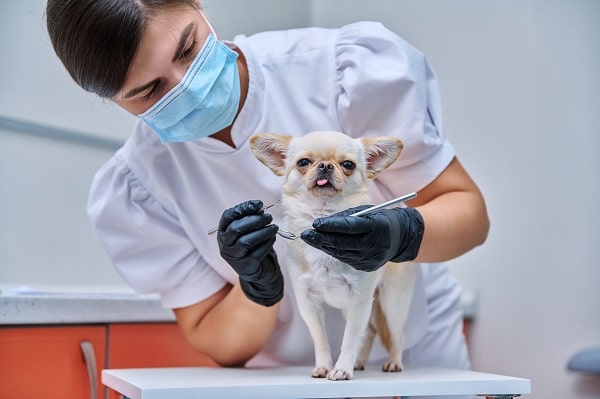Dogs are susceptible to staph infections for the same reasons humans are: bacteria can get into cuts and scratches and cause an infection. The word staph is short for Staphylococcus aureus, the specific type of bacteria that causes the infection. And when left untreated, these infections can become quite serious. So to help you keep your furry friend healthy and safe, this article will provide you with some information about treating a dog staph infection. This article has everything you need to know, from identifying the infection to getting rid of it.
Contents
The Dangers Of An Untreated Dog Staph Infection

A dog staph infection is a serious illness that requires swift and comprehensive treatment. If you leave it untreated, the infection can quickly spread throughout a dog’s body, causing more severe and potentially life-threatening problems. These include fever, aggressive behavior caused by brain inflammation, and bad reactions to medications or anesthetics during surgery.
Other notable dangers include sepsis caused by bacteria entering the bloodstream or an eye infection rendering a dog partially or totally blind. Dog owners should therefore be sure to have their pet examined promptly if they notice signs of staph. Early detection and swift treatment are vital for protecting your pup from long-term harm.
Common Causes Of A Staph Infection

While there are many different causes of a staph infection in dogs, some are far more common than others. Here is a closer look at some of the things to watch out for:
Cuts And Scratches: One of the most common ways a dog staph infection can take hold is through cuts and scratches on the skin. If your dog has wounds or lacerations, check them regularly for signs of infection.
Poor Hygiene: Dogs are naturally curious creatures and often put things in their mouths that they shouldn’t. This can lead to ingesting harmful bacteria that may cause staph infection.
Bites: Another common way dogs can get staph infections is by being bitten by another animal. The risk for infection is incredibly high in this case, whether it’s from another dog, cat, or even a human.
Hormone Issues: Some dogs are more prone to developing staph infections than others, which may be due to a hormonal imbalance. If your dog has an overactive thyroid or adrenal gland, they may be at higher risk for developing staph or other infections.
External Parasites: Finally, if your dog is suffering from external parasites, like fleas or ticks, it could also run the risk of contracting a staph infection. These parasites can carry harmful bacteria that can easily make their way into your dog’s body.
Signs Of A Staph Infection

Along with being aware of the different potential causes of a staph infection, it is crucial to recognize the signs to treat it quickly. Some of the most common symptoms to look for include the following:
Swelling, Redness, And Tenderness: If your dog is exhibiting any of these symptoms, especially in a particular area like their legs or joints, it could be a sign that they have staph. A gentle touch with your hands will help you determine whether there is an underlying problem.
Lethargy Or Fever: Another common sign to look for when identifying a staph infection is a change in your dog’s behavior. If they seem lethargic, tired, or have a higher fever than usual, it could be a sign that something is wrong.
Discharge Or Pus: A surefire indication of any infection is the presence of discharge or pus. If your dog’s skin is oozing any liquid, have them checked by a vet as soon as possible.
Patchy Fur: Dogs with a staph infection may also shed their fur in patches. This can indicate that the skin is irritated and inflamed, making it susceptible to bacteria.
Excessive Itching: If your dog is constantly scratching, licking, or biting its skin, then it’s likely that they have an underlying infection. This may be due to a staph infection or another problem, such as allergies.
Treatment Options

If you suspect your dog may have a staph infection, it is vital to seek treatment quickly. Some of the most common treatment options include the following:
Antibiotics: Antibiotics are one of the most common and effective ways to treat a staph infection in dogs. These medications kill harmful bacteria in your dog’s body and prevent further infection. The most common types of antibiotics used to treat staph infections include amoxicillin, cephalexin, and trimethoprim.
Topical Treatments: In some instances, your vet may recommend a topical treatment as an alternative or in conjunction with antibiotics. These creams and ointments work by soothing irritated skin and speeding up the healing process. For example, topical treatments for staph infections in dogs include sulfur ointment, bacitracin spray, and povidone-iodine.
Surgery: If your dog has a particularly severe or deep staph infection, they may require surgery to fully remove the bacteria from their body. This is a last-resort option, but it can be highly effective in getting rid of a staph infection. Again, your vet can provide specific recommendations based on your dog’s case.
Regardless of the treatment option that your vet recommends for your dog’s staph infection, it is crucial to follow their instructions closely and provide your dog with consistent care and support as they recover.
Tips To Prevent Further Staph Infection

When it comes to preventing staph infections in dogs, the best defense is a good offense. Proactivity is vital to keep your pup healthy, so regular visits to the vet are an essential first step. Additionally, proper hygiene and grooming habits can go a long way toward preventing bacterial or fungal infections from occurring in the first place. Be mindful to keep cuts or skin irritations clean and dry, as allowing these areas to stay moist can facilitate the proliferation of bacteria or fungi.
Also, ensure you tend to any areas with signs of infection immediately! Lastly, take caution whenever introducing your pup to other animals or specific environments – this cautiousness will ensure that you’re controlling what external factors might be coming into contact with your pup’s skin. By following these steps, you’ll be on the right track toward keeping your canine companion safe from staph infections!
Be Aware Of Dog Staph Infections And How To Treat Them!
Staph infections in dogs are a serious concern, but with timely treatment and proper care, your dog can fully recover. The important part is that you educate yourself on the different causes, signs, and treatment options for staph infections in dogs so that you can quickly and accurately identify any symptoms and get your dog the help they need. By being proactive about your pup’s health, you can rest assured that they will be free from this nasty infection! So don’t wait – take action today to protect your dog from staph infections.


